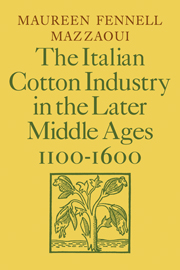Book contents
- Frontmatter
- Contents
- List of illustrations
- Preface
- List of abbreviations
- Map
- Introduction
- PART ONE THE ROLE OF COTTON IN THE MEDITERRANEAN ECONOMY
- PART TWO THE ORGANIZATION OF THE NORTH-ITALIAN INDUSTRY
- 3 The spread of cotton manufacture
- 4 Technological innovation
- 5 The structure of demand: products and markets
- 6 Guild and entrepreneurial structures
- PART THREE THE GROWTH OF COTTON MANUFACTURE NORTH OF THE ALPS
- APPENDICES
- Notes
- Select bibliography
- Index
5 - The structure of demand: products and markets
Published online by Cambridge University Press: 05 March 2012
- Frontmatter
- Contents
- List of illustrations
- Preface
- List of abbreviations
- Map
- Introduction
- PART ONE THE ROLE OF COTTON IN THE MEDITERRANEAN ECONOMY
- PART TWO THE ORGANIZATION OF THE NORTH-ITALIAN INDUSTRY
- 3 The spread of cotton manufacture
- 4 Technological innovation
- 5 The structure of demand: products and markets
- 6 Guild and entrepreneurial structures
- PART THREE THE GROWTH OF COTTON MANUFACTURE NORTH OF THE ALPS
- APPENDICES
- Notes
- Select bibliography
- Index
Summary
Technological innovation which permitted the mass production of cotton goods at relatively low cost represented one facet of the successful growth of cotton manufacture in northern Italy. A second dimension was the aggressive marketing of cotton cloth which involved the emission of a diversified range of products into regional and international trade and the stimulation of new patterns of taste and consumption in European society.
By the last decades of the twelfth century, the products of the north-Italian cotton industry were firmly established in international commerce. The extant documents indicate exports to Spain, southern France and Sicily. Another important market was North Africa. It is probable that Italian textiles passed together with locally produced cloth across the Saharan caravan routes. In the eastern Mediterranean the two main outlets were Byzantium and the Black Sea ports. From the time of the Mongols, Syrian and Turkish merchants had exchanged cotton fabrics and other goods for Russian furs and slaves in the Crimean port of Sudak. In the late thirteenth and early fourteenth centuries the establishment of Italian colonies in Caffa, Tana and Trebisond was accompanied by a lively commerce in cotton cloth, part of which was re-exported to Russia and central Asia where it was utilized for tents, clothing, and household furnishings. The intensity of this traffic is indicated by the fact that throughout the region, cotton cloth (bucherame, boccasino) was adopted as the monetary unit according to which the price of other merchandise was reckoned.
- Type
- Chapter
- Information
- Publisher: Cambridge University PressPrint publication year: 1981



